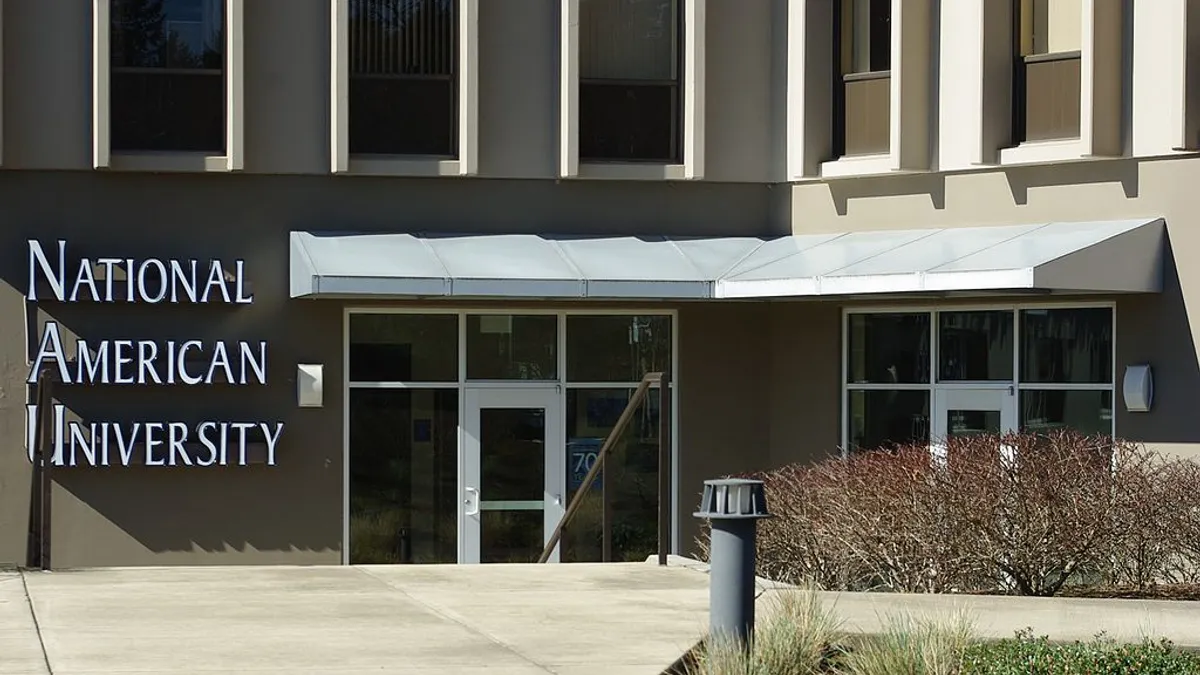For more than a year, leaders of the for-profit chain National American University have peddled the institution's transition to online education as something of a Hail Mary, a way to turn around the once-thriving college, which has suffered from plummeting enrollments and shaky finances.
By the view of some observers, the plan seems to be failing.
National American's latest filing with the U.S. Securities and Exchange Commission (SEC) shows it has been shedding students at a steady clip. Enrollment dropped 41%, to 3,313 students, between May 2018 and May 2019, according to the filing. Many of the lost students were enrolled online. National American University Holdings, its parent company, reported an operating loss of $6.9 million that fiscal year, and it had just $1.3 million in cash and cash equivalents, one-quarter of what it had a year ago.
The company's financial position has been so precarious that in SEC filings last January, it raised "substantial doubt" about its ability to continue operating in a year. The U.S. Department of Education increased its oversight of the institution and demanded collateral in the form of a letter of credit in order for it to continue receiving student aid through the federal Title IV program. It is a substantial source of revenue for the institution, amounting to about 78% in the 2019 fiscal year.
National American appealed to the department, which set the required amount of the letter of credit to 10% of the college's Title IV aid, or $7.3 million. To pay that, a subsidiary of the company that runs the university sought an $8.5 million loan from another college operator, the Center for Excellence in Higher Education (CEHE).
The college must pay the loan fully by Oct. 15, 2020. National American also remained on the department's list of institutions on heightened cash monitoring as of Sept. 1, 2019, for concerns relating to its financial responsibility. This status subjects it to higher levels of financial scrutiny in order to receive federal aid. The company also filed its most recent 10K form with the SEC late, citing "a delay in completing the financial statements."
"It's an ongoing crisis," said Trace Urdan, a managing director at investment bank and consulting firm Tyton Partners who analyzes the for-profit sector. "There's no doubt."
National American could survive in the most ideal circumstances, according to experts Education Dive interviewed. But it is nearly inevitable that it will not, at least not in its current financial straits or, likely, under its current ownership.
Who will step in?
How state regulators, the institution's accreditor and the Ed Department ㅡ higher ed's "regulatory triad" ㅡ handle a prospective shutdown or major shift in National American's operations could be telling.
The sudden collapses of for-profits Education Corporation of America and Vatterott Educational Centers, along with the schools owned by the nonprofit Dream Center Education Holdings, left thousands of students scrambling to figure out how to finish their degrees. They also intensified scrutiny on the industry and led to questions about how the triad would react the next time a for-profit college appeared to be headed for closure.
In the aftermath of those closures, critics questioned why the department or the schools' accreditors didn't intervene sooner to ensure the schools had a plan for helping students finish their degrees. Speaking with Education Dive earlier this year, some observers blamed the fallout from the closures on the colleges' lack of preparedness, even as their financial positions suggested shuttering may be possible.
Another factor is the primary measure of assessing an institution's financial health, a number called the financial responsibility composite score and that those observers said is an inadequate and ill-timed alert for the possibility of a closure.
This composite score relies on three metrics drawn from institutions' annual financial statements: the primary reserve ratio, the equity ratio and the net income ratio.
The score is tracked on a scale from -1 to 3. If a college falls below 1.5, the department may subject it to additional oversight in order to remain eligible for Title IV funding. If it dips below a score of 1, then the department no longer considers them "financially responsible." Lower scores usually bring on additional oversight, such as having to post a letter of credit, as National American was required to do.
However, the composite score is not measured in real-time, sources told Education Dive earlier this year, and it may be delayed by six months or more. In its latest SEC filing, National American listed its most recent score as 1.1, though that number is subject to the Ed Department's review.
Given the company's status as a publicly traded company, those responsible for keeping an eye on its fiscal health should still know it's worsening. For now, though, none of the parties charged with overseeing or running National American have publicly intimated the institution could close.
The Education Department is "aware of National American University's financial posture and is closely monitoring and assessing the institution's financial health and administrative capability," Angela Morabito, department spokesperson, wrote in an email to Education Dive. "The Department is focused on protecting students and taxpayers from the adverse effects of school disruptions. The Department has allowed the institution to participate in student aid programs on a provisional basis."
Ronald Shape, the president and CEO of National American University Holdings, wrote in an email to Education Dive that the university "is nearing completion of" its shift online, "which includes key initiatives to assist its working adult students in achieving their educational goals and to prepare them for a rapidly evolving and increasingly competitive employment market." The university is moving forward with a new "strategic plan" headed into 2020, Shape wrote. He said he was unavailable for an interview or additional questions.
"It's an ongoing crisis. There's no doubt."

Trace Urdan
Managing director, Tyton partners
National American launched in 1941, offering specialized business training to women in western South Dakota as the National School of Business. It branched out to other states in the 1970s, attempting to reach more of its target population of working adults and other nontraditional students. By 1998, it was offering online degrees.
The college experienced steady growth into the 2000s, eventually offering a range of 128 programs from a bachelor's degree in Nuclear Enterprise Security/Studies to language certificates in Hindi, Urdu and Mandarin, and even a doctoral education degree in community college leadership.
In the fall of 2012, roughly the peak of its expansion, National American enrolled 11,683 students and had about 35 physical locations.
But the breadth of its programs was part of the problem, Urdan said. At the same time, more postsecondary education providers were cropping up, giving the adult learners National American was going after other low-cost ways to get a college degree or other credential.
National American found itself crowded out of the growing market. Enrollment slumped, and in October 2018, the trustees decided to lean into online learning. The company said it would teach-out its on-the-ground programs and phase out its facilities entirely. A month later, it suspended new enrollment in 34 of its programs.
The university's narrowing focus does not seem to have remedied its financial woes. Total revenue for National American University declined from $74.8 million in the 2018 fiscal year to $50.9 million in 2019, a 32% drop.
In May, National American's accreditor, the Higher Learning Commission (HLC), flagged it as being in financial distress based on information the university filed with the SEC in April. After the HLC investigated the institution in the summer, it concluded it was in compliance with its rules and removed the designation.
Steve Kauffman, an HLC spokesperson, said the agency doesn't comment on specific institutions but directed Education Dive to documents it last made public on National American. The institution must file a report with HLC by the end of the year that details how it has promoted scholarship and made improvements in technology and career services.
Is a sale ahead?
Urdan said National American's reputation is linked to its physical locations, and so while it may appear prudent to cut them out, recruiting students based on the university's online presence alone could prove difficult. Online enrollment slid from 4,342 students in May 2018 to 2,760 in May 2019.
And then there's the matter of the loan from CEHE. Given its finances, it is unclear how National American will fulfill that obligation. Eric Juhlin, the CEO of CEHE, wrote in an email to Education Dive that "at this point" the company is confident National American will satisfy its obligations. He declined to comment further.
Dahn Shaulis, a self-professed higher ed watchdog who writes the College Meltdown blog, said the likely scenario is that CEHE, which has faced its own set of regulatory and legal controversies and has been accused of misleading students, will buy National American because it already has a stake in its debt.
Public universities have also attempted forays into online education, either through acquiring an institution with existing online infrastructure, as Purdue University did with the for-profit Kaplan University, or creating an online system themselves.
As many as two dozen state university systems, flagship campuses and other public universities have considered adding more comprehensive online options, Inside Higher Ed reported earlier this year. But public universities could be hamstrung by their lack of experience with adult students and the services they require, Urdan said.
For-profit colleges may appeal to this demographic because they tend to offer more flexibility and online options than a traditional four-year institution. National American, with its existing digital footprint, could interest a major public institution, similar to the Purdue-Kaplan deal, Urdan said.
But liabilities abound for National American, which is the subject of two separate lawsuits, one from a former employee, alleging violations of federal rules and that the institution unlawfully paid bonuses to employees who recruited students. The other is from several students who said they were misled by the quality of the programs National American professed to offer, which left them with substantial debt.
"I see real downsides," Shaulis said on a potential sale of National American, "There's a lot of risk involved."























